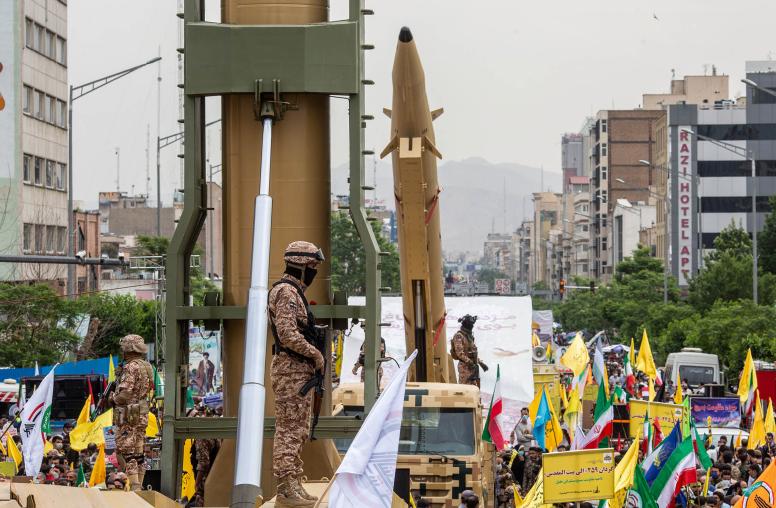Are the U.S. and Iran Really on the Brink of War?
Despite the heightened rhetoric following Soleimani’s killing, neither side has said it wants a military showdown.
I’ve covered Iran since my first visit in 1973 during the shah’s reign and many times since the 1979 revolution. I can’t remember a moment—even during the takeover of the U.S. Embassy in 1979—when the U.S. and Iran seemed closer to some form of overt or covert military showdown. The killing of Qassem Soleimani was the boldest U.S. act in confronting Iran since the 1979 revolution, tantamount to an act of war. Although U.S. officials have characterized the move as “decisive defensive action.” However, if Iran had assassinated the general who heads Central Command (the unit overseeing U.S. military operations in the Middle East and South Asia), Washington would have similarly viewed it as tantamount to an act of war.

The drone strike may have eliminated Soleimani, the nemesis of U.S. forces and many U.S. allies. But the aftermath of his death—and the emotional outpouring among Shiites across the region—has also spawned serious risks to U.S. troops and civilians as well as broader stability in the Middle East, including for many U.S. partners.
There’s been an unnerving breathlessness in the escalation of U.S.-Iran tensions in just a few days—with no long-term strategy or possible resolution in sight by anyone, anywhere. In the meantime, the world’s most volatile region is bracing for more violence and, in the worst-case scenario, another conflict.
The Regional Picture
The region—wracked by wars in Syria, Iraq, Libya, Yemen and instability in others—can ill afford new violence. As the president of Iraq, Barham Salih, told me over the weekend, the Middle East still hasn’t finished the last war with ISIS, which until the collapse of its caliphate last year was considered the greatest security threat to the entire world. Salih called the prospect of another war “utter madness.”
Iraq is now at the epicenter of tensions between Iran and the United States—and its leaders are deeply concerned about once again becoming the theater of some kind of overt or covert campaign. Iraq has experienced a variety of wars on its soil for 40 years—23 years during the rule of President Saddam Hussein and 17 years since the U.S. invasion in 2003.
The Military Balance
Both the U.S. and Iran have a long reach militarily. The United States has troops deployed in Iraq, Syria, Saudi Arabia, Kuwait, Qatar, and Bahrain with smaller units elsewhere. Iran has established a network of proxy militias—armed, aided, funded and/or trained by Tehran—in Iraq, Syria, Lebanon, the Palestinian territories and Yemen, with smaller allies underground elsewhere. Both countries also have military and commercial ships in the Persian Gulf, the vital sea-lane through which a third of the world’s shipped oil exports flows. Both countries also have significant cyber capabilities—and have used them against each other.
Any conflict between the two countries would involve disparate force strengths. The United States has vastly superior air power, arms, and manpower to fight a conventional war. Iran has proven masterful at asymmetric war, notably through tactics such as suicide bombings and hostage-takings that can traumatize an entire nation at limited cost. After 40 years, Tehran also has a deep bench. Soleimani had gained mythical status, but the Revolutionary Guards and the Quds Force have long experience in warfare. Soleimani’s replacement is his longtime deputy, Esmail Ghaani.
A Mutual Lack of Understanding
The United States and the Islamic Republic have little understanding of each other; the bluster in both countries (under successive leaders) reflects the deep-seated fear they have of each other. In the past, Washington and Tehran made tentative overtures to each other. In the 1980s, the Reagan administration engaged in a covert arms-for-hostage swap with Iran. In the 1990s, President Mohammad Khatami called for an end to the “wall of mistrust” and a “dialogue of civilizations.” In 2000, the Clinton administration acknowledged the U.S. role in orchestrating a coup against a democratically elected government in Iran in 1953. But neither government was on the same page at the same time.
The two nations came closest to a kind of informal rapprochement in 2013. President Hassan Rouhani won office on a platform promising to negotiate a nuclear deal with outside world, including the United States, and ending Iran’s pariah status. At the U.N. General Assembly in September, three weeks after Rouhani’s election, President Barack Obama placed a call to Rouhani’s cell phone when the Iranian leader was in New York. That launched two years of diplomacy between Iran and the world’s six major powers, which produced the 2015 nuclear deal with the unwieldy name of “Joint Comprehensive Plan of Action.” Its chief negotiators, Secretary of State John Kerry and Foreign Minister Mohammad Javad Zarif, both noted that they had spent more time with each other over two years than with any diplomat from any other country. The subsequent deal won unanimous support in a U.N. resolution.
Is Diplomacy Possible?
President Trump withdrew from the deal in May 2018 and re-imposed economic sanctions. He called for a broader deal with Iran that would encompass other issues, including Tehran’s missile program, support for extremist movements and interventions in the Middle East. Iran has expressed interest in diplomacy if it included the future lifting of sanctions.
France has led an effort—backed by other European powers—to broker a deal. But neither Washington nor Tehran has been willing to take the first major step. Now both countries are into election cycles. Iran faces parliamentary elections in February this year, and presidential elections next year. (Iran has two-term limits, so Rouhani is now a lame duck.) And this month Washington moves into its own national election cycle.
The dangers ahead are real; the prospects of diplomacy, at the moment, seem slim. For all the heated rhetoric, however, politicians and military officials in both countries have said they do not want war. Let’s hope they take the steps required to prevent it.



